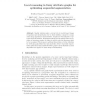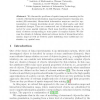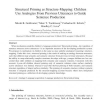141 search results - page 4 / 29 » Mapping relational structure in spatial reasoning |
DAGSTUHL
2006
13 years 8 months ago
2006
Cognitive Vision has to represent, reason and learn about objects in its environment it has to manipulate and react to. There are deformable objects like humans which cannot be des...
NGC
2006
Springer
13 years 7 months ago
2006
Springer
This paper examines two seemingly unrelated qualitative spatial reasoning domains; geometric proportional analogies and topographic (landcover) maps. We present a Structure Matchin...
GBRPR
2007
Springer
14 years 1 months ago
2007
Springer
Spatial relations play a crucial role in model-based image recognition and interpretation due to their stability compared to many other image appearance characteristics. Graphs are...
RSFDGRC
2005
Springer
14 years 28 days ago
2005
Springer
We discuss the problems of spatio-temporal reasoning in the context of hierarchical information maps and approximate reasoning networks (AR networks). Hierarchical information maps...
COGSCI
2011
12 years 11 months ago
2011
What mechanisms underlie children’s language production? Structural priming—the repetition of sentence structure across utterances—is an important measure of the developing ...



